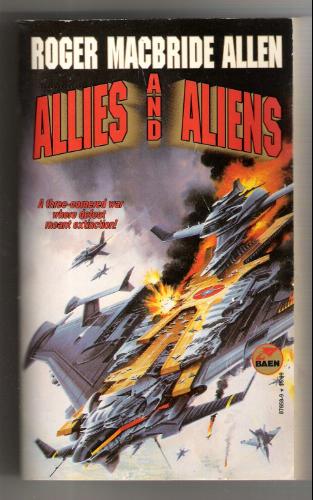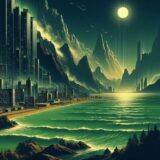Allies and Aliens
Roger Macbride Allen
Baen
I find it hard to remember, looking back over twenty years, which book served as my first proper introduction to Baen Books. One possible candidate was On Basilisk Station, by David Weber, while the other was Allies and Aliens. On Basilisk Station is the first book in a very famous military-SF series, while Allies and Aliens is far less well known. Which is a shame, in my opinion, because it deserves much better.
Allies and Aliens is actually a combined volume holding Allan’s first two published novels; The Torch of Honor and Rogue Powers. The books have had minor editing – and been given a cover that caught my young eye at once – but are otherwise unchanged.
The Torch of Honor starts out with a planet – New Finland – which has been attacked and conquered by the Guardians, a mysterious force of humans hailing from outside known space. As they are deploying a revolutionary defence system, the League of Planets cannot launch an immediate counterattack. Instead, they are forced to rely on an untested teleport system to transport a small army to New Finland, where it can help the locals recover their planet. Unfortunately, only one ship – with a crew of two, husband and wife – can reach New Finland in time to get there before the defence system is complete.
Told in first person by the husband, the book follows his adventures as he reaches New Finland, slips down to the planet and sets up his teleport station to receive the troops. But success doesn’t follow immediately afterwards. The Guardians have dispatched a giant flying aircraft carrier/spaceship to take control of the planet – and if that ship cannot be destroyed, New Finland will merely be the first planet to fall.
Unusually, Rogue Powers moves from first-person to third-person – and deploys a much larger cast of characters. It starts with the crew of a League of Planets survey ship, who discover that they have been hijacked by the Guardians and conscripted into serving as technical specialists. As they start fitting into their new life, they become involved in the discovery of intelligent non-human life in the Guardian-controlled system – and realise to their horror that the aliens might be capable of giving the Guardians war-winning weapons.
In the meantime, reeling from the liberation of New Finland, the League of Planets launches a desperate search for the homeworld of the Guardians, only to discover – to their horror – that the Guardians are deploying new and deadly weapons. But the aliens have plans of their own and the Guardians may merely be the first targets as they seek to take human space for their own …
The thing that most strikes me about Allies and Aliens, looking back, is the presence of true hard-SF. Fans of The Lost Fleet will probably enjoy the long slow dance of space combat in this book, where there is no instant manoeuvring or other magic technology. The only true advancement in the book is the FTL generator (which helps power the teleport too) but even that isn’t magic. Starships have to be careful or they may end up unable to slow down and end up drifting through space forever (a fate that strikes some of the ships in the book.)
There’s also very little else that we wouldn’t recognise (the development of computer technology, it should be noted, is quite underestimated by the author.) One particularly amusing example is the brief discourse on military equipment by the characters, including how it is kept as simple as possible. Sure, hover-tanks exist, but they would be buggers to fix on campaign. Instead, military technology isn’t that more advanced from present-day tech.
It is debatable if this is true of the giant aircraft carrier spacecraft in the book, however, something that strikes me as a ‘cool, but stupid’ concept. (I give the author points for lampshading this in Book II.) As the main character points out, the ship could have been destroyed at any moment. Only the simple fact that the defenders were effectively held hostage to its continued existence saved its hull – for a while.
The alien society and biology is also interesting – and, in some ways, unique. While I don’t want to go into details, they have good reason for being what they are – and for resenting humanity, when they find out about us. There are also good twists on the sort of weapons they deploy, although I do wonder why they couldn’t solve their own problems using the same brand of technology. And, perhaps an unusual step, the aliens have their own subgroups, some with different interests to others.
The character development, it must be admitted, is much better in Book II than Book I. (The notes state that the books were polished up for their reissuing by Baen.) Most of the main characters are connected in some way and have their flaws. I particularly liked the biologist who serves as ambassador to the aliens, then realises the true horror of their existence – and the fact that she has become an unwitting collaborator with the Guardians.
I don’t think that Allan was the first writer to pull off the ‘drunken old salt takes command and makes good’ plot, but it is also a major part of Book II and fits in very well.
There are some odd points, I should admit. In the second book, Mac Larson – the narrator of the first book – is put on trial for publically warning the American-ethnic planet of the dangers of relying on giant space carriers. (After playing a major role in destroying the enemy space carrier.) I confess I have some difficulty in understanding why he was tried at all – a quick reread of the first book proves all of his points. But history does note that HMS Prince of Wales was sent out without air cover in 1942 and was sunk by the Japanese, even though the Royal Navy had been the first to use carriers against (Italian) battleships.
Overall, however, Allies and Aliens is well worth a read.











1 Comment